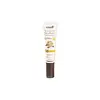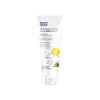What's inside
What's inside
 Key Ingredients
Key Ingredients

 Benefits
Benefits

 Concerns
Concerns

 Ingredients Side-by-side
Ingredients Side-by-side

Water
Skin ConditioningZinc Oxide
Cosmetic ColorantCyclohexasiloxane
EmollientButyloctyl Salicylate
Skin ConditioningPropanediol
SolventDicaprylyl Carbonate
EmollientPropylheptyl Caprylate
EmollientDisiloxane
Skin ConditioningPentylene Glycol
Skin ConditioningTrimethylsiloxysilicate
EmollientLauryl Polyglyceryl-3 Polydimethylsiloxyethyl Dimethicone
Skin Conditioning1,2-Hexanediol
Skin ConditioningArgania Spinosa Kernel Oil
EmollientPersea Gratissima Oil
Skin ConditioningCalendula Officinalis Flower Oil
MaskingCeramide NP
Skin ConditioningDisteardimonium Hectorite
StabilisingMagnesium Sulfate
Polyglyceryl-2 Dipolyhydroxystearate
Skin ConditioningIsododecane
EmollientTriethoxycaprylylsilane
Acrylates/Polytrimethylsiloxymethacrylate Copolymer
Skin ConditioningPolyhydroxystearic Acid
EmulsifyingHydroxyacetophenone
AntioxidantDimethicone
EmollientPolyglyceryl-4 Diisostearate/Polyhydroxystearate/Sebacate
EmulsifyingLecithin
EmollientEthyl Palmitate
EmollientIsostearic Acid
CleansingIsopropyl Myristate
EmollientDipotassium Glycyrrhizate
HumectantPolyglyceryl-3 Polyricinoleate
EmulsifyingTocopherol
AntioxidantDipropylene Glycol
HumectantCholeth-24
EmulsifyingHydrogenated Lecithin
EmulsifyingWater, Zinc Oxide, Cyclohexasiloxane, Butyloctyl Salicylate, Propanediol, Dicaprylyl Carbonate, Propylheptyl Caprylate, Disiloxane, Pentylene Glycol, Trimethylsiloxysilicate, Lauryl Polyglyceryl-3 Polydimethylsiloxyethyl Dimethicone, 1,2-Hexanediol, Argania Spinosa Kernel Oil, Persea Gratissima Oil, Calendula Officinalis Flower Oil, Ceramide NP, Disteardimonium Hectorite, Magnesium Sulfate, Polyglyceryl-2 Dipolyhydroxystearate, Isododecane, Triethoxycaprylylsilane, Acrylates/Polytrimethylsiloxymethacrylate Copolymer, Polyhydroxystearic Acid, Hydroxyacetophenone, Dimethicone, Polyglyceryl-4 Diisostearate/Polyhydroxystearate/Sebacate, Lecithin, Ethyl Palmitate, Isostearic Acid, Isopropyl Myristate, Dipotassium Glycyrrhizate, Polyglyceryl-3 Polyricinoleate, Tocopherol, Dipropylene Glycol, Choleth-24, Hydrogenated Lecithin
Water
Skin ConditioningZinc Oxide
Cosmetic ColorantDibutyl Adipate
EmollientTitanium Dioxide
Cosmetic ColorantIsononyl Isononanoate
EmollientCetyl Alcohol
EmollientNiacinamide
SmoothingCetearyl Alcohol
EmollientAvena Sativa Kernel Flour
AbrasiveC12-15 Alkyl Benzoate
AntimicrobialGlycerin
HumectantJojoba Esters
EmollientGlyceryl Stearate
EmollientAllantoin
Skin ConditioningCaprylic/Capric Triglyceride
MaskingAluminum Hydroxide
EmollientTriethoxycaprylylsilane
Polyhydroxystearic Acid
EmulsifyingStearic Acid
CleansingHelianthus Annuus Seed Wax
Skin ConditioningSodium Stearoyl Glutamate
CleansingBisabolol
MaskingTocopheryl Acetate
AntioxidantCitric Acid
BufferingSodium Hyaluronate
HumectantLavandula Angustifolia Oil
MaskingCitrus Medica Peel Oil
Sodium Benzoate
MaskingPotassium Sorbate
PreservativeXanthan Gum
EmulsifyingCeramide NP
Skin ConditioningCeramide AP
Skin ConditioningPhytosphingosine
Skin ConditioningCholesterol
EmollientSodium Lauroyl Lactylate
EmulsifyingCeramide EOP
Skin ConditioningPolyglycerin-3
HumectantEthylhexylglycerin
Skin ConditioningCarbomer
Emulsion StabilisingWater, Zinc Oxide, Dibutyl Adipate, Titanium Dioxide, Isononyl Isononanoate, Cetyl Alcohol, Niacinamide, Cetearyl Alcohol, Avena Sativa Kernel Flour, C12-15 Alkyl Benzoate, Glycerin, Jojoba Esters, Glyceryl Stearate, Allantoin, Caprylic/Capric Triglyceride, Aluminum Hydroxide, Triethoxycaprylylsilane, Polyhydroxystearic Acid, Stearic Acid, Helianthus Annuus Seed Wax, Sodium Stearoyl Glutamate, Bisabolol, Tocopheryl Acetate, Citric Acid, Sodium Hyaluronate, Lavandula Angustifolia Oil, Citrus Medica Peel Oil, Sodium Benzoate, Potassium Sorbate, Xanthan Gum, Ceramide NP, Ceramide AP, Phytosphingosine, Cholesterol, Sodium Lauroyl Lactylate, Ceramide EOP, Polyglycerin-3, Ethylhexylglycerin, Carbomer
Ingredients Explained
These ingredients are found in both products.
Ingredients higher up in an ingredient list are typically present in a larger amount.
Ceramide NP is a type of ceramide and formally known as ceramide 3.
Ceramides are intercellular lipids naturally found in our skin that bonds dead skin cells together to create a barrier. They are known for their ability to hold water and thus are a great ingredient for dry skin.
Ceramides are an important building block for our skin barrier. A stronger barrier helps the skin look more firm and hydrated. By bolstering the skin ceramides act as a barrier against irritating ingredients. This can help with inflammation as well.
If you would like to eat ceramides, sweet potatoes contain a small amount.
Read more about other common types of ceramides here:
Ceramide AP
Ceramide EOP
Polyhydroxystearic Acid is a soft wax made from castor oil.
It is is a texture thickener, emulsifier, and film-former. Emulsifiers prevent ingredients from separating, such as oils and waters.
Polyhydroxystearic Acid may not be fungal acne safe.
Learn more about Polyhydroxystearic AcidTriethoxycaprylylsilane is a silicone used to bind and stabilize ingredients.
As an emulsifier, it helps prevent ingredients from separating. This can help elongate the shelf life of products.
Triethoxycaprylylsilane is often used to coat mineral sunscreens ingredients to help give a better feel. It also helps reduce oxidative stress in sunscreens.
Learn more about TriethoxycaprylylsilaneWater. It's the most common cosmetic ingredient of all. You'll usually see it at the top of ingredient lists, meaning that it makes up the largest part of the product.
So why is it so popular? Water most often acts as a solvent - this means that it helps dissolve other ingredients into the formulation.
You'll also recognize water as that liquid we all need to stay alive. If you see this, drink a glass of water. Stay hydrated!
Learn more about WaterZinc Oxide is a mineral broad-spectrum UV filter; it is the broadest UVA and UVB reflector approved by the FDA. It also has skin protectant and skin soothing properties.
Zinc oxide is one of the most effective broad-spectrum UV filters. It protects against UVB, UVAII, and UVAI. In comparison to its counterpart titanium dioxide, zinc oxide provides uniform and extended UVA protection.
Another great benefit? This ingredient is highly photostable so it won't degrade easily under sunlight.
A common myth is that mineral UV filters are widely believed to primarily reflect UV light.
However, modern research shows titanium dioxide absorbs UV radiation like chemical filters (~95% absorption & 5% reflection).
Zinc oxide has great skin soothing properties so you'll likely find this in sunscreens formulated for sensitive skin or babies/children. It is unlikely to cause "eye sting" like other sunscreen ingredients.
Regulatory agencies consider zinc oxide to be non-toxic and safe. It has also been shown to not penetrate the skin.
Unfortunately, this ingredient does leave a visible white cast. This is why mineral sunscreens are often less cosmetically elegant than chemical or hybrid ones.
In cosmetics, zinc oxide can be found in both non-nano and nano-sized forms. The nano version is used to reduce white cast and improve the texture of sunscreen formulas.
There are ongoing concerns surrounding nano-zinc oxide's impact on marine ecosystems and whether it can be absorbed into skin.
Regarding marine ecosystems and coral reefs, there is no conclusive evidence that any form of zinc oxide (or any other sunscreen ingredients) will cause harm. The science is still developing but many consumers are keeping a close eye on this issue.
Please note, many destinations have reef-safety sunscreen rules. For instance, the U.S. Virgin Islands advises all visitors to use non-nano mineral sunscreens.
There has also been some stir about whether micronized or nano zinc oxide has potential photoxicity and absorption through the skin/lungs.
An in-vitro (done in a test tube or petri dish) study demonstrated micronized zinc oxide to have potential phototoxicity. There's no need to fret; the EU Commission's Scientific Committee on Consumer Safety has stated, "The relevance of these findings needs to be clarified by appropriate investigations in vivo." Or in other words, further studies done on living organisms are needed to prove this.
Current research shows zinc oxide nanoparticles do not penetrate intact or sunburned skin. They either remain on the surface or in the outermost layer of dead skin (stratum corneum).
Zinc oxide is one of only two classified mineral UV filters with titanium dioxide being the other one.
Fun fact: Zinc has been used throughout history as an ingredient in paint and medicine. An Indian text from 500BC is believed to list zinc oxide as a salve for open wound. The Ancient Greek physician Dioscorides has also mentioned the use of zinc as an ointment in 1AD.
Learn more about Zinc Oxide